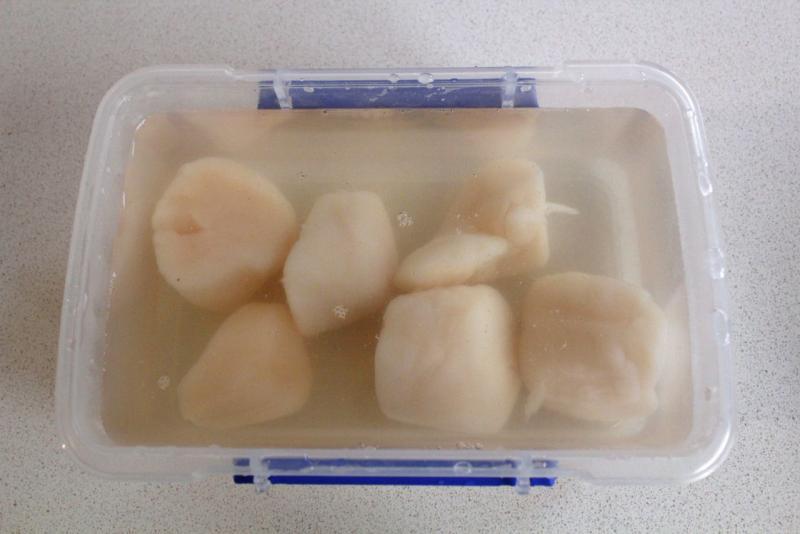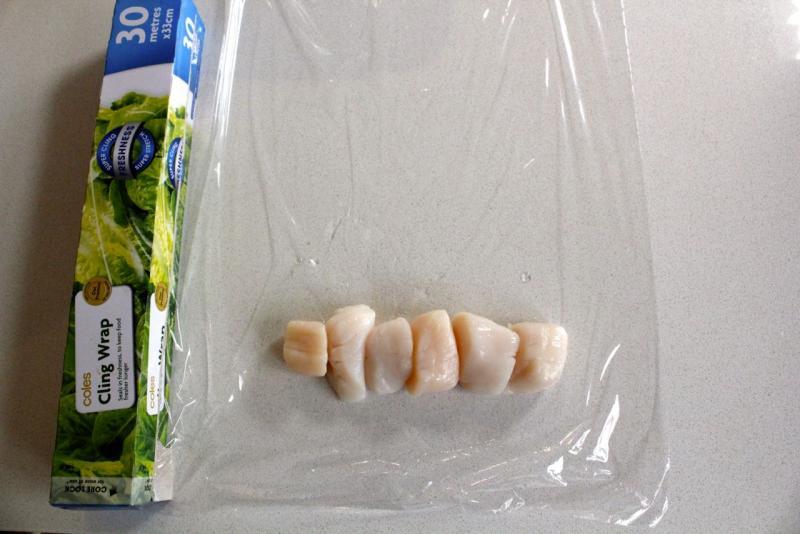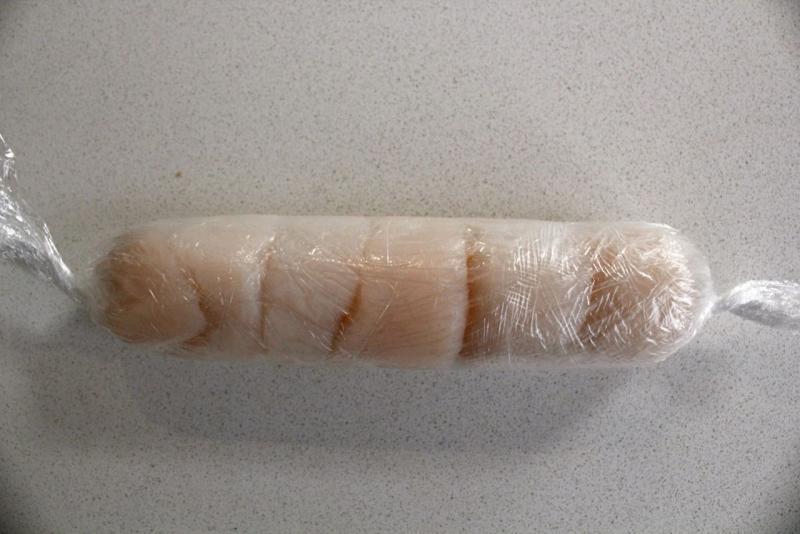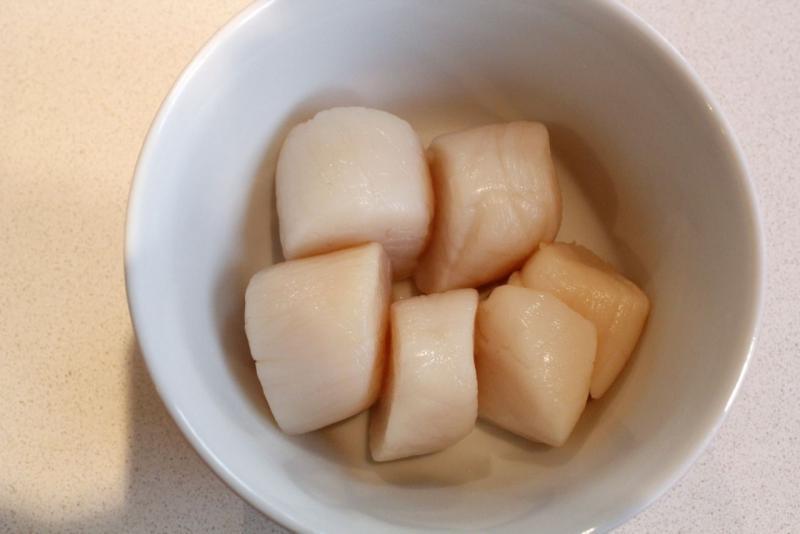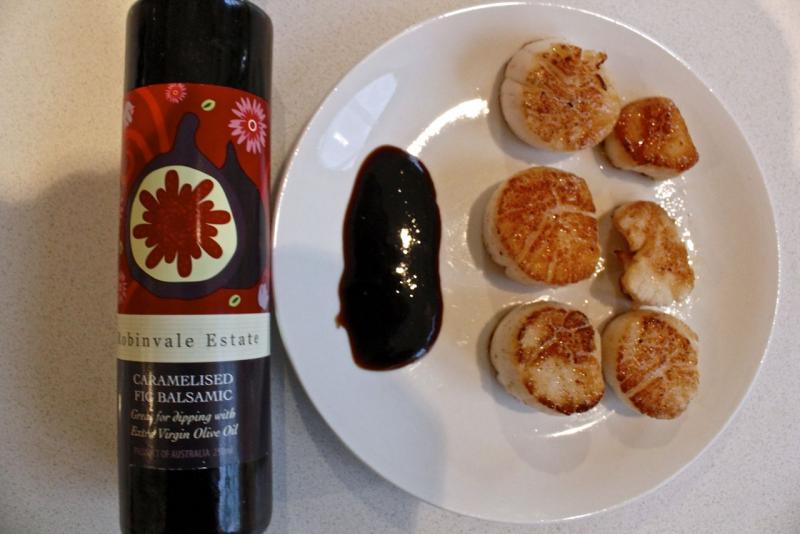
ChrisZ
participating member-
Posts
469 -
Joined
-
Last visited
Content Type
Profiles
Forums
Store
Help Articles
Everything posted by ChrisZ
-
I thought I'd share the technique I've been using to cook scallops SV. When I first searched for info on scallops here a few years there wasn't much, but I found a few tips on other sites. We eat fresh fish at least once a week and when I'm at the fishmonger I sometimes get a 'handful' of scallops at the same time if I feel like a treat. A few weeks ago I tried cooking scallops normally - ie. just pan frying them - to compare them against sous vide. The sous vide scallops were much, much softer. I also brine the scallops before cooking them and I'm not sure if it's the brining or the SV, but when I sear the SV scallops they caramelise much much quicker than ones that haven't been brined and SV'd first. I use an equilibrium brine, with the ratios from MC for a basic seafood brine. When I'm ready to cook them, the trick is to roll them up in cling film first... ...then bag them as usual. I've been cooking them at 50C for about 30 minutes, I haven't noticed if higher or lower temperatures make much difference. I want them to be cooked through - that's the point of the SV step - but these temperatures are too low to pasteurise so I have to be mindful of safety. 30 minutes seems to work well. I read one blog that suggested scallops cooked at 35C gave them an amazing custard-like texture, but I like mine hotter (I'm the same with fish - I tried Tetsuya's ocean trout at 42C but it just didn't feel right to me). Today I tried 45C and didn't notice any difference from cooking them at 50C - I thought I'd try a lower temp than 50C as searing them afterwards bumps up the temperature so they don't 'feel' cold. When they're done I take them out the bag and pat them dry, this helps them to caramelise. Finally I heat a frying pan with olive oil and quickly sear them to get some colour and crust. They're already cooked so the frying pan can be smoking hot as all I'm after is colour. As noted above, I find that SV scallops colour up very quickly, much quicker than raw scallops. As a snack, I like mine dipped in a locally produced caramelised fig balsamic. Delicious!
-
In search of the perfect Parma
ChrisZ replied to a topic in Australia & New Zealand: Cooking & Baking
Look, I admire your search for the perfect chicken parma but I think there's something decidedly un-Australian about making one that actually tastes like chicken. I love it when you can find a dodgy old pub where everything that comes out of the deep-fryer tastes exactly the same, no matter if it's beef, chicken, seafood or whatever. I like pubs where the question 'how often do you change your oil' is met with a blank stare. There's a unique flavour to deep-fried pub food that is fundamental to an 'authentic' chicken parma. I have no doubt your chicken parma is delicious - and next time I make them I'll try adding sage, that sounds good - but to suggest there's skill involved in frying the chicken for an Aussie chicken parma is like suggesting there's a level of skill involved in getting drunk ;-) -
The Food Safety and Home Kitchen Hygiene/Sanitation Topic
ChrisZ replied to a topic in Kitchen Consumer
If you have a digital thermometer - and I'm guessing that most of us interested in sous vide have at least one - then just leave a few glasses of water in different parts of the fridge overnight (to equalise) and then test their temperature. When we bought a new fridge I found its default settings to be a bit warm - up to 8C in places. I lowered the thermostat until it was about 4-5C max, with some liquids freezing if they're near the rear of the fridge at the top (like Nickrey). As others have said, IF you don't open the bags and IF you cooked at a time / temperature to pasteurise then your food will be safe for quite a while in the fridge. I actually had some pork ribs that I had cooked for 3 days at 58C, and they were kept sealed in the fridge for over 6 months. They reheated fine and I ate them with no ill effects, although I realise now that was a bit silly. But 6 days is certainly no problem as long as your rig is accurate. I bought a cheap foodsaver clone for $44 from an online store, it works fine. It's been useful for me to get the hang of vacuum bagging food. You don't need to spend a fortune on a chamber sealer to make the step up from ziploc bags. -
Have you considered ditching flour altogether and using almond meal (or other nut meals) instead? Better in every way.
-
In search of the perfect Parma
ChrisZ replied to a topic in Australia & New Zealand: Cooking & Baking
Oh I totally agree. I love a good chicken parma and with our lack of a national dish it's much more deserving than a silly pie dropped in a bowl of soup. Although I'd suggest that chicken parmas are slightly more prevalent in the southern states. I make them a lot and it's a good way of using up leftover pasta sauce. I don't worry too much about the ham as I don't think it adds much overall, but it is useful to stop the sauce from making the chicken soggy. Half the point of crumbing and frying the chicken is to add texture, and if you dump the tomato sauce straight on the chicken it tends to go soggy. So if nothing else, a slice of ham can prevent that and help keep the chicken crispy... I don't have a favourite cheese, but while you want a cheese with flavour I always like to add a bit of mozzarella too to get some stretch. I generally use a mix of parmesan (or grana padano) and mozzarella simply because they're the two cheeses we always have in the fridge. But I wouldn't say no to gruyere or jarlsberg, which would also go well. And I always add a smear of basil pesto on the top as well - that's the one variation I always make. Yum! -
There is an older thread here on fish & chips for those of us in the Southern Hemisphere. Sea Perch (aka Orange Roughy) is delicious with a distinctive taste but it's highly endangered and if you eat it you'll be reincarnated as a worm. For the past year my favourite has been monkfish.
-
Pound cakes are easy because the recipe is in the name - one pound of everything. Basically you have 4 ingredients - butter, sugar, eggs and flour, and you use equal quantities of each (doesn't have to be 1 pound, but if it is you'll have lots of cake). The trickiest part is to remember that an egg is roughly 60g (2 oz), and that you'll want to use SR Flour. You mix together the butter and sugar until creamy, then mix through the eggs, then the flour. Cupcakes are usually made from a pound cake recipe and it's a very rich, moist type of cake.
-
Thanks for the feedback. My hunch was that it wouldn't be very accurate for the price but I'm disappointed that it appears to be so inaccurate. I didn't expect it would have a PID controller but even a bang-bang thermostat can be much more accurate than that. I'm guessing that the heating component of the unit is an existing slow-cooker and they've just re-packaged it for sous vide, without the accuracy that we associate with the technique. It would be nice to think you have a defective unit and that they're normally much more accurate, but my bets are that they're all the same. Would love to hear from more users or customers, especially those with the equipment to measure the long-term accuracy of the unit.
-
I'm really curious about this. What have been the differences? My understanding is that the recipe for a pound cake is all in the name - equal quantities (1 pound, originally) of butter, sugar, eggs and flour. In different recipes the base quantity may differ from 1 pound, and the flour and sugar may be listed as cups and not by weight, but a pound cake will always have equal quantities of those 4 ingredients. So I'm curious to know how different pound cake recipes are different? FWIW when I've had troubles with cakes sinking, it's been because of too much leavening agent - something that can easily happen when using baking soda or baking powder as opposed to a self-raising flour. When a cake bakes, there's a point where the starches from the flour and the proteins in the eggs have enough strength to hold the cake's shape and ideally this happens at the same time that the cake has risen to its peak. The result will be a perfect cake. But if there's too much baking powder or soda, then the cake can rise too quickly and all the air can bubble out the top, letting the cake collapse again before it sets. The same thing can also result from the batter being too wet (not viscous enough to hold the air bubbles in) or the oven too hot (the cake again rises too quickly so the air bubbles escape before it sets) or the cake being taken out too soon (the air bubbles cool and shrink before the cake has fully set).
-
It looks like Sunbeam (in Australia) have introduced a consumer sous vide machine, which doubles as a slow cooker - the MU4000. Anyone have any experience or feedback? The manual isn't great but the price is attractive. I'm not sure if they're reacting to Breville re-badging the Sous Vide Supreme, but it's a quarter of the price (Breville is $800 vs Sunbeam $200) and you can also use it as a slow cooker. It's hard to see how big it is although they say 5.5 litres, and I guess only testing will reveal how accurate the thermostat is. The temperature increments in 1 degrees and the timer only works in 10 minute intervals, but it looks more attractive than a rice cooker rig and is probably aimed at the same market. Including a rack for vacuum pouches is a nice touch. Could be good as an introduction to sous vide - not sure it's big enough or accurate enough to appeal to more serious cooks, but it's Sunbeam's first effort and hopefully they can improve from here.
-
Love this thread! Awesome work Keith. Just a few thoughts- - Regarding beer can chicken, I've tried it a few times and I always drink the beer first and use an empty can. So I was interested when you wrote "contrary to myth, it is not the beer in the can that keeps the chicken moist." Am I doing it wrong? - Is butterflying the same as spatchcocking, or is there some subtle difference? - There's a Jamie Oliver technique of boiling a lemon and then putting it in the cavity of the chicken with some herbs before roasting. The hot lemon speeds up the cooking process as well as contributing flavour. I've used this technique a number of times and am always amazed at how well the lemon flavour permeates the chicken. It works especially well with thyme / lemon thyme. It's simple technique with a very dramatic result on the flavour of the end result.
-
Following on from the original infographic collection posted above, the same site has published another batch that attempts to depict recipes in a visual form only. Following on some of the responses above, I'll add that I find these interesting and worth sharing (or worth discussing), but that doesn't mean I think they're all good. The people who create these things are designers - possibly students - who may not have any experience or expertise with food. This second collection is more interesting, because I think they're a lot less successful than the first lot. I generally enjoyed the first collection and found several of them (such as the knife ones) genuinely informative. This second collection highlights the fact that recipes have been presented in pretty much the same way for so long we don't think about it, and that it's pretty hard to come up with something better. Certainly every cooking book that I've got, and that my mother has, and that her mother had, all present recipes in the same way - a list of ingredients at the top, followed by step-by-step instructions. The format that the Modernist Cuisine team use is the first innovation in publishing recipes that I've seen, and this collection of largely unsuccessful infographic recipes suggests that developing a new recipe format was a bigger accomplishment for the MC team than it may appear. Generally, I don't think these infographics have been very successful, but it does make you think how a well presented visual recipe would negate literacy and language issues.
-
I use this recipe, which I found on the internet way back in 2001: http://everything2.com/title/Chocolate+Fondant I couldn't guess how many times I've made it and the results are always spectacular.
-
It all comes down to the ratio of cream - chocolate, and if the ganache is left to set before it's used. In terms of ratios, white chocolate seems to behave differently to milk and dark chocolate - which will make a setting ganache with higher ratios of cream. With white chocolate I find equal ratios, or slightly more chocolate than cream, to work better. If the ganache is poured over the cake before it has set, so it effectively sets on the cake (which would allow marbling to be done directly on the cake) then the ganache will have more of a fondant style consistency, as opposed to a set ganache which is then scooped up and piped or spread. A white chocolate ganache that is left to set on the cake will end up looking more yellow than one which is left to set, and then piped or spread. If you have some spare time it's not hard to set up an experiment. Buy some white chocolate and break it into small amounts, e.g. 20g or 50g. Them mix in cream in different ratios. If you count the chocolate as 100% weight, you could try 10 variations in 10% increments, from 50% weight of chocolate up to 150%. It wouldn't take too long to set up, and the chocolate and cream would cost less than $10 and it would give you a record you will have for ever. And if you wait for the ganaches to set, you can also experiment to see how well each one pipes, whips, spreads, tastes, etc etc, which will give you more records to keep.
-
If it's not a fondant it could be a white chocolate ganache. A whipped ganache is more like buttercream than fondant, but if not and there's a higher ratio of cream to chocolate then it would look like the photo.
-
You really piqued my curiosity! I phoned Cadbury's customer help line today and they said their cocoa is dutch processed. That's interesting, as I was under the assumption that dutch processed cocoa was red, while unprocessed cocoa was brown. As I said above, I have also assumed that there's s noticeable taste difference between them. However they're just assumptions and I'm happy to be corrected, and as I said above I don't think I've come across plain cocoa in Australia...
-
A collection of cooking infographics was posted on a graphics site a few days ago - I have enjoyed looking through them all and thought they were worth sharing.
-
AFAIK neither the Cadbury nor Nestle cocoa powders sold in Australian supermarkets are dutch processed. Do you know for sure that they are? No, I just assumed because Cadbury/Bourneville cocoa is more reddish than brown and is made in the UK. I just did a quick Google search which didn't reveal a conclusive answer, with some sites saying it is and others saying it isn't, so unless I spend longer searching I'm still not sure either way. Again it is an assumption, but I thought there was a noticeable difference between plain and dutched cocoa, so if I'm wrong about Cadbury being dutch process then I'm also wrong about that - as I haven't noticed any big differences when using cocoa that is clearly identified as dutch process!
-
I've got 3 types of cocoa in the pantry. As the others have already said, Valrhona is lovely but in these parts it's very expensive, so I tend to save it for special occasions. In terms flavour it's superb though and has a beautiful rich colour. The everyday cocoa I use from the supermarket is Van Houten, which is fine. The supermarket choice is either Cadbury, Nestle or Van Houten and the Van Houten is easily the best of the 3, although I grew up using Cadbury so there's a certain amount of nostalgia there. When I bake anything chocolate I dust the tins with cocoa, not flour, so I also have a pack of cheap generic brand cocoa that I use just for that. It's occurred to me that I don't think I've seen cocoa in Australia that isn't dutch process, so if I needed it I'm not sure where I'd get it.
-
Sorry I'm not directly answering your question, but there have been several studies done on the health effects of chicken soup (here's a blog that Google found, and there are plenty more like it). Once the studies started showing that chicken soup might be just as effective as pharmaceuticals the next step was to figure out why, so they started examining the compounds / chemicals etc. So there have been a number of scientific papers published on the chemistry of chicken soup and there's even a recipe! If you're really keen, you could read them and see what they have to say about the compounds in it and what's going on. Might not be much use if you're vegetarian but it's still a starting point.
-
I think I've posted this before, but I had a baker tell me that when he was younger everyone used to add powdered milk to the dough as it had the miraculous effect of making the bread softer, last longer, and brown more evenly. He said it got to the stage over many years where they were adding so much powdered milk to the dough they used to call it 'milk bread'. Then someone figured out that soy flour did the same thing but was much cheaper, so they all switched to that instead. Some recipes for home-made bread still include powdered milk.
-
Gorgeous, thanks for the link. Loads of great photos on the main page too. The consistency between the 3 slices is impeccable, and suggests that they're able to make the spheres in various sizes as needed, so I don't think it's just water that's beading or the slices would vary more. I haven't seen tapioca pearls that clear and perfect so I would agree that it's some form of spherification.
-
I recall being stumped by exactly the same thing. I did fry the bacon. If I remember correctly, the bacon softens considerably during the cooking process so there's no harm in frying it until crispy. If you haven't already, try searching this topic for 'carbonara' - you'll see posts from other people efforts on the same recipe including mine.
-
I have wondered how large pie and tart shells - the sort with vertical sides - are blind baked in commercial quantities. As a teenager I worked in a bakery, and small tart shells were blind baked in tin trays (8 x 4 for 32 at a time I think) simply by stacking an identical tray on top, this worked because the tart shells had sloping sides and I guess the trays were designed to be stacked. But we didn't make any large tarts, and the ones we bought in all had the same sloping sides style, not the perfectly vertical side that you would expect of a cheesecake (for example). Trays for large tarts / pies / cheesecakes with vertical sides can't be stacked, and in commercial situations I'd be surprised if they mucked around with parchment and ceramic beads. So how is it done?
-
Coconut chutney foam (4.282) is recommended as an accompaniment / garnish to the caramelised carrot soup, so I thought I'd give it a go. It would be my first attempt at a 'foam' so I was prepared for failure, otherwise I would've taken photos. I began by googling to see if there were any useful comments and advice from others, and found this blog which had very helpful pictures and comments: The first step is to puree coriander leaves (cilantro), mint leaves and green chilli and pass it through a sieve. In the blog above, it was noted that this only produced a dried mince and not a puree that could be sieved. I thought that if I doubled the quantities it might be easier to work with, but it didn't make a difference. So no sieved puree, just a dryish herb paste. Thanks to the blog, I didn't worry about this because it all gets blended anyway. The next step is to blend the herbs with coconut milk and coconut cream. Because I had doubled the quantities of herbs, I was surprised to find that I needed almost all of them. The combined weight of the herbs and chilli in the book only added up to 14g, but the next step called for 20g of puree. It didn't occur to me that this could be a mistake so I was thankful I had doubled up, and weighed out 20g. With a can of coconut milk and coconut cream open in front of me, I couldn't see any difference in texture or consistency between them - it's possible the taste is different, or that different brands vary more. 200g of each went into the blender. Although I don't have a high-powered blender, after a few minutes the herbs seemed to be pureed and I had a light green liquid that was reassuringly close to the photos in both MC and on the blog. The next step was to season, and at this point I realised that I didn't really like the taste of the green liquid. At all. I'm not exactly sure what was going on here, as there were other aromas in the kitchen that were mixing together, but my first reaction was that I was tasting compost. I decided to continue to see what would happen. Time for the interesting bit. I had to hydrate 3.4g of low acyl gellan F and .6g sodium citrate with 20g water. I weighed out 20g of chilled filtered water, and began sprinkling the gellan on top while whisking it in. The gellan instantly soaked up all the water and I was left with a few gummy balls of jelly. I added a bit more water but didn't even get close to something liquid. This definitely looked like something had gone wrong. As a point of reference, 20g water is 4 teaspoons, and the gellan / sodium citrate is about 1 teaspoon powder. Whisking in 1 teaspoon of powder into only 4 teaspoons of liquid definitely felt like a mistake. I checked the online errata and found an entry for the coconut chutney foam. However it was to do with the herb puree - only 10g is needed, not 20g, hence the reason I would've run out if I hadn't doubled up the herbs. But no mention of the gellan or water. I decided to rely on the blender again to solve problems and so I added the globs of jelly and blended everything for a few more minutes, poured it through a sieve to remove any stubborn herb bits, and poured the lot into a saucepan and bought it to a simmer (this fully hydrates the gellan). I could see that the gellan was immediately 'working' as the liquid was thickening immediately. Even as I poured the liquid out of the saucepan, a thin film formed around the base and sides as the saucepan cooled. According to MC, it should set completely in about 10 minutes but I didn't need it for a while, so I put it to one side. When the gel had set, I had another taste. It still tasted odd to me, but I also didn't like the texture - it was quite granular. I was sure something has gone wrong with the gellan. The next step was to blend the solid gel, and to my surprise this turned it into a super smooth, very creamy liquid which easily poured into the siphon. All graininess vanished. I charged the siphon with 1 nitrous bulb and heated it in a bowl of hot water. After the carrot soup was ready, I tested the siphon and found it easy to produce dollops of coconut foam - I have to say I was really surprised this worked, but I was also concerned that I simply didn't like the taste. I was prepared to make an emergency run to the supermarket to get some creme fraiche as a backup. The magic happened when I tasted the foam with the soup, which changed everything. By itself, the foam tasted of coriander (cilantro), but when you accompanied it with the soup it was the hint of mint that came through. When also combined with freshly grated ginger, ajowan seeds and thyme, the result was amazing. Mint is not a flavour I would think to add to a carrot soup, but it worked really well. The coriander supported the flavours without being assertive - a few of my guests commented that they don't normally like coriander but in this case it was delicious. I am still amazed at how the different flavours blend together so well, and change the overall character of the soup. The carrot soup by itself is beautiful, and the addition of fresh ginger adds a lovely zing to it, but the coconut foam takes it to another level again.

